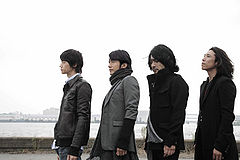Mr.Children (Japanese band)
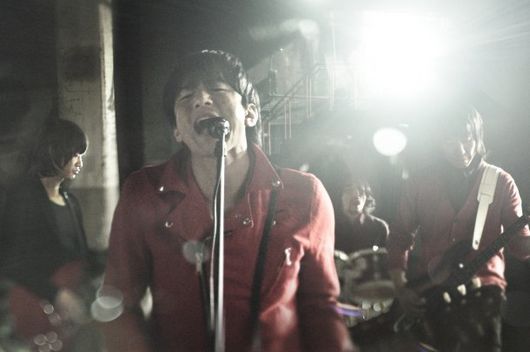
Mr.Children (ミスターチルドレン) is a Japanese pop-rock band under the TOY'S FACTORY label.
Contents
Members
- Sakurai Kazutoshi (桜井和寿) (Vocal)
- Tahara Kenichi (田原健一 (Guitar)
- Nakagawa Keisuke (中川敬輔) (Bass)
- Suzuki Hideya (鈴木英哉) (Drums)
Biography
They were all born in 1969 (except for Sakurai Kazutoshi who was born in 1970). This was the year that the Woodstock Festival took place, and it was also an epoch-making year in rock 'n' roll music history. Kenichi Tahara, Keisuke Nakagawa, and Hideya Suzuki met in junior high school in Tokyo. Sakurai was from another part of Tokyo (Nerima), so they all came from the same part except for him. They spent their teen years in the Tokyo suburbs and in high school, Sakurai, Tahara, and Nakagawa met.
Mr.Children started from 1989. The name was chosen while they were talking in a diner. By that time, they were influenced by the band, Echoes. The leader of that band was Tsugi Jinsei. Because of this influence, their music became political and sarcastic. But when they picked up this new name, they changed their attitude towards their band, and they decided to broaden their horizons. Sakurai remembers at that time they tried to make something that they didn't have. They passed auditions at the livehouse, "La Mama", and they became entitled to play there.
At "La Mama", their popularity with the audience increased, and they were scouted to debut as professionals. At that time, there was a debut boom. But they were very serious about their music. In '91, they reached a change and announced 3 months off. After this, they were refreshed and they returned to the livehouse more sophisticated. When they came back, they tried to adapt a new arrangement, but other people said they preferred their previous arrangement. Inaba from TOY'S FACTORY said, "I felt their potential in their songs." Through their networking, they got a contract with Bad Music. So they played as the opening act for Jun Sky Walkers and learned what it meant to be professional. Also, they met producer Kobayashi Takeshi. He was known as the music composer for Kuwata Keisuke and Koizumi Kyoko. They wanted to find a strategy to be on the side of counterculture against the band boom.
They started collaboration work with Kobayashi at his home. Sakurai learned how hard it was to be professional through this experience. Kobayashi didn't hesitate to speak his mind on Sakurai's compositions and lyrics. They went over and over them. In 1992, Mr.Children's debut album, EVERYTHING, represented this collaboration.
At the time they debuted, there were some big bands which dissolved, and karaoke became popular. They wanted to be in the front lines of the music scene. They had to compete in the big music scene, so they put priority in their compositions. They created the album, Kind of Love, which was the accomplishment of the combined energy and hard work of Sakurai and Kobayashi. Also, their techniques improved.
At that time, the technology revolution in the music scene grew very fast. They adapted new systems for their album. The system enabled them to control instruments digitally. For their third album, Versus, they wanted to get a new energy into each sound. They wanted to be refreshed, so they used Waterfront Studio in New York. It's the same studio used by Lenny Kravitz. As a result, their compositions and band characteristics matched. Mr.Children were chosen as the next break in music magazines. That was just two years since their debut.
Sakurai sought songs that were popular. Suzuki recalls Sakurai saying he wanted to sell 1 million units. The single, "Replay", was a tie-up for a snack commercial, and 4 months later, "CROSS ROAD" was used as a drama theme song. They had finally found golden tunes which touched people through these songs. "CROSS ROAD" sold very well and their tours were also successful. In the 22nd week of the release of the single, they finally reached a million sales. Because of "CROSS ROAD", they became known as a love song band.
The hit, "innocent world", followed and their popularity became stable. However, this song became the turning point for the band. Most of their songs were created aiming for popularity, but "innocent world" was a song in which Sakurai was revealing his inner self. Through that song, he wrote about himself; for example, you see in the lyrics the words, "mr. myself". According to Sakurai, "Since that time, I started releasing myself." Despite this, it was supported by many audiences. Sakurai said, "We wanted to be a big monster" (meaning they wanted to be hugely successful). As a result, they created Atomic Heart. That was an experimental album because they mixed the clear sound of instruments with digital sounds, resulting in what is called "DigiRock" ("Digital Rock").
Also, the circumstances surrounding the band had changed. They switched their production label to Oorong (which is still their current production label), and producer Kobayashi reached the peak of his career. He produced two ideas, two opposite tours at once, one called TOUR INNOCENT WORLD, and the other, TOUR Atomic Heart, without a break. One tour focused on the physical performance. The other tour was the combination of the band with the latest technology on a huge set. They were two contrasting ideas. Also, they created a documentary movie of the band's history. So '94-'95 were the busiest times in their band history.
Even though they were busy on tour, Mr.Children were still aggressively creative. During their first tours, they released "Tomorrow never knows". That song was composed in a hotel during their tour. It was about life itself and also about the real circumstances that the band was in.
In the beginning, the coupling for that single was supposed to be "everybody goes -Chitsujo no Nai Gendai ni Drop-Kick-", but they released it as a single instead a month later. They did this during their tour because they didn't want to waste even a minute. It was very intensive creativity which resulted in that work. Therefore, Sakurai's taboo in creating music disappeared. Finally, they had concerts in big halls like the Budokan. Right after that, their next tour, "TOUR Atomic Heart", was waiting for them. They had concerts at the Budokan during both tours, so they didn't feel anything special about it. "innocent world" won the Record Award (Japan's equivalent to the Grammys), and 1994 became Mr.Children's year.
They didn't take off either Christmas or New Year, and on January 7, 1995, they started a new tour. Using a total of 72 faces of cube screen, it was a big entertainment show that consisted of lasers and sounds beyond imagination. The band's rise to the top continued.
Also, they became more active towards charity. Kuwata Keisuke introduced them into joining the Act Against AIDS concerts, and the song which Kuwata and Sakurai sang as a duet, "Kiseki no Hoshi", became the campaign song for those concerts. The stage of the "LIVE UFO" was like a rock opera. They covered songs by The Rolling Stones and Bob Dylan, the golden age of rock standard. It was a time to reflect on the days that they had rushed through. Then they worked on their documentary movie, [es], for which they had gone abroad to shoot a movie location. At the time they finished the theme song for [es], the movie opened in theaters. Also, in the summer, they had an outdoor concert called [ku:].
Mr.Children's phenomenon went on from '94-'95 through to '96. With the coming of a new year, the single, "Namonaki Uta", was released in February and became a big hit. This single was about a love story of one's pure devotion to one's partner. It was a very creative composition, and very fresh. However, the band began to feel some emptiness in their minds, a feeling which can't be understood unless one has reached the peak of success.
It was something different from the time they had worked hard and dreamt of selling a million records. Their dream had come true, and now every single they released became a hit, so they took it for granted. Said Suzuki, "I felt like I was carrying a burden somewhere." People around him said that they had reached the top music scene, but they found themselves feeling an emptiness in their minds. The interest from media extended to Sakurai's private life because he had succeeded so young (in his 20s), but they solved that problem by continuing to go on rather than taking a break.
Their activity after the release of Atomic Heart became more concentrated. They hadn't produced an album for two years. They had a lot of songs that were left unreleased. They started recording them with some new songs, and it went over the song limit of an album. Then they found a solution: make two albums at the same time, two different albums. The initial plan was to make a world recording, travel to America, Europe, and Jamaica. That was really a stimulating idea, but because of several reasons, that plan was revised to recordings in Tokyo, New York, and London.
After the release of "Hana -Mémento-Mori-" as a single, the album, Shinkai, followed. It was a very heavy album for those people who usually listened to 3-minute pop music. It was like a test to find out if you were a real Mr.Children fan. The sales reached triple million.
After the completion of the album, they started their tour. The name of that tour was "regress or progress". In that tour, they played all the songs of the album Shinkai. It was a trial for them because they had never done that before. The size of the concert halls was arena, and they held 55 conerts. The number of audiences for this tour broke records. However, the schedule was very tight and the content of those concerts was also very tight, because whenever they played Shinkai in the concerts, it reminded them of their dark feelings.

Another album they produced was BOLERO. Like Ravel's "Bolero" (original classical composition), it went step-by-step. Shinkai used analog sounds. On the other hand, they tried using digital sounds with BOLERO. Five of the songs in this album were already million sales hits, giving it the feel of a best album, but the remaining new six songs were not typical pop hit chart songs; for example, "Time Machine ni Notte" and "Kasa no Shita no Kimi ni Tsugu". Those songs were more offensive. This album was like the summary of two-and-a-half years' work. In 1997, the tour's final concert was held at the Tokyo Dome.
Afterwards, rumors started circulating of the band's dissolution. Of course they had planned on taking one year off, but they never thought about dissolution. Sakurai's amusing witty remark: "The band will dissolve only when we have no more talent and have relationship problems with each other."
On March 31, 1997, at Ebisu Garden Hall, they held a secret live for only 1,000 fans. The audience there was very relaxed. The band played 10 songs while drinking. It was a celebration for them to mark the end of their tour. They left the stage after performing "Mata Aeru Kana".
Sakurai said, "Rock bands needed a paid vacation." In fact, they hadn't had a vacation in 2-3 years. Tahara and Nakagawa went to driving school. A friend of Suzuki's left a message on his answering machine stating: "Why don't you go for a drink, or hang out?" Sakurai bought a computer in order to set up a new environment for his compositions. Then he started reading manuals.
Nakagawa and Suzuki had some plans. They made a new session band named "Hayashi Hideo", and they went on a livehouse tour. Fujii Kenji from My Little Lover and Yamanaka Sawao from the pillows joined them. Tahara went to other band lives or he listened to CDs at home. Also, he attended Hayashi Hideo lives. That was a good chance to watch Mr.Children's players objectively.
Even though they were off, their visual products (videos) were released continuously. They released their video clips (music videos) and tour documentary. Sakurai continued to work on new compositions whenever he found the time. Sometimes he used the guitar as he used to, but he also tried electronic samplings to make a basic stage. Sometimes they got together even though they were off. They played soccer and baseball. At other times, they ran into each other in bars. Sakurai took advantage on such occasions to introduce his demo tapes as if he was recommending them cigarettes. He already had some of the songs in his hands. It was going to be their new direction once they started making music again and returned to the music scene. He adapted computer sounds to his sound.
"Nishi e Higashi e" went beyond trials and it was a great song. It was good timing, too, and it was used for a drama. As a result, it became the revival of compositions. "Nishi e Higashi e" and "Hikari no Sasu Hou e" represented the fresh them, not like their old songs, because of their complicated loop of riffs and the cascading style of words. This was the period when home-based musicians (creating music outside of a recording studio) were getting attention. The band's sound was heavy and thick.
In April '98, after a year vacation, they came back to the music scene. Suzuki: "When we played together again, I was very nervous but excited." The band had been born in junior high and high school, but after a year break, they all felt refreshed. They started recording, and with "Owarinaki Tabi", they returned to the music scene. The phrase, "Tozasareta Doa no Mukou ni / Atarashii Manika ga Matteite" ("There is something new behind a closed door, something new waiting for me..."), was very impressive. Said Sakurai, "It means that door is in my mind, so I closed it by myself. The person who opens this door is me. I closed it; I have to open it." After this, they started recording at a private studio which was similar to their home environment. Except for the songs which Sakurai had already created, other songs were made through experimentation in these sessions. On his vacation, Sakurai had enjoyed surfing, so his approach towards creating songs became similar to surfing. Sakurai: "There is a way of riding on waves, not only on big waves, but also small waves. Look at it to see how to catch it. It's something similar to composing." Their next album was DISCOVERY. Sakurai had changed. He was not the same person who had made Shinkai. He became in his 30s and shaped up (eliminated unnecessary things).
The same thing can be said about their tour. They didn't bring unnecessary things. They brought only necessities, the most important of which was music. They didn't use big screens, but they made the audience excited. They caught the audience only through their songs. They didn't use any decorations or tricks. The audience recognized four members playing together. That is the real Mr.Children. During their recordings, they had become simpler. They wanted to show the audience the real them. That was the concept of that tour. Then there was something left that they had never done. That was to release a live album. The concert in Sapporo was released as their live album. The name was 1/42 because the total number of concerts they held for that tour was 42, and they picked one night of that tour, thus the title.
Trivia
- Fastest Selling Single (first week sales) of All Time: "Namonaki Uta" (1.2M)
- Double Million Seller Singles: 2nd overall (1st - CHAGE and ASKA)
- Million Seller Singles: 2nd overall (1st - B'z, 3rd - GLAY)
- Million Seller Albums: 2nd overall (1st - B'z, 3rd - DREAMS COME TRUE)
- Sales Overall: 2nd overall (50,635,000) (1st - B'z (75,614,000))
- Consecutive No.1 Hits: 2nd overall (1st - B'z)
- No.1 on Oricon Year-End Charts: 1994 ("innocent world"); 1996 ("Namonaki Uta") and 2007 (HOME)
- Won Japan Record Grand Prix in 1994 for "innocent world" and won it again 10 years later for "Sign"
Discography
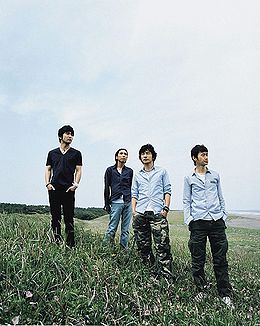
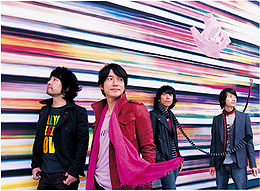
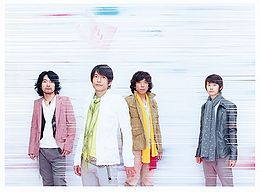

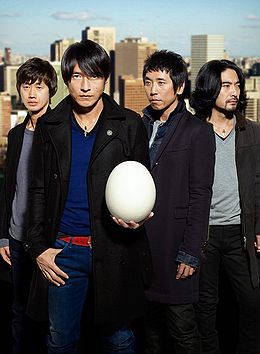
Studio Albums
- [1992.05.10] EVERYTHING
- [1992.12.01] Kind of Love
- [1993.09.01] Versus
- [1994.09.01] Atomic Heart
- [1996.06.24] Shinkai (深海; Deep Sea)
- [1997.03.05] BOLERO
- [1999.02.03] DISCOVERY
- [2000.09.27] Q
- [2002.05.10] IT'S A WONDERFUL WORLD
- [2004.04.07] Shifuku no Oto (シフクノオト)
- [2005.09.21] I ♥ U
- [2007.03.14] HOME
- [2008.12.10] SUPERMARKET FANTASY
- [2010.12.01] SENSE
- [2012.11.28] [(an imitation) blood orange]
- [2015.06.04] REFLECTION
- [2018.10.03] Juuryoku to Kokyuu (重力と呼吸)
Best Albums
- [2001.07.11] Mr.Children 1992-1995
- [2001.07.11] Mr.Children 1996-2000
- [2007.05.10] B-SIDE
- [2012.05.10] Mr.Children 2001-2005 <micro>
- [2012.05.10] Mr.Children 2005-2010 <macro>
- [2017.05.10] Mr.Children 1992-2002 Thanksgiving 25 (Digital)
- [2017.05.10] Mr.Children 2003-2015 Thanksgiving 25 (Digital)
Live Albums
- [1999.09.08] 1/42
Singles
- [1992.08.21] Kimi ga Ita Natsu (君がいた夏)
- [1992.12.01] Dakishimetai (抱きしめたい; Hold Me Tight)
- [1993.07.01] Replay
- [1993.11.10] CROSS ROAD
- [1994.06.01] innocent world
- [1994.11.10] Tomorrow never knows
- [1994.12.12] everybody goes -Chitsujo no Nai Gendai ni Drop-Kick- (everybody goes -秩序のない現代にドロップキック-)
- [1995.05.10] 【es】~Theme of es~
- [1995.08.10] See-Saw Game ~Yuukan na Koi no Uta~ (シーソーゲーム ~勇敢な恋の歌~; Brave Love Song)
- [1996.02.25] Namonaki Uta (名もなき詩; Nameless Song)
- [1996.04.10] Hana -Mémento-Mori- (花 -Mémento-Mori-; Flower)
- [1996.08.08] Machine Gun wo Buppanase -Mr.Children Bootleg- (マシンガンをぶっ放せ -Mr.Children Bootleg-; Fire the Machine Gun)
- [1997.02.05] Everything (It's you)
- [1998.02.11] Nishi e Higashi e (ニシエヒガシエ; To the West, To the East)
- [1998.10.21] Owarinaki Tabi (終わりなき旅; Endless Journey)
- [1999.01.03] Hikari no Sasu Hou e (光の射す方へ; In the Direction of the Light)
- [1999.05.12] I'LL BE
- [2000.01.13] Kuchibue (口笛; Whistle)
- [2000.08.09] NOT FOUND
- [2001.08.22] Yasashii Uta (優しい歌; Gentle Song)
- [2001.11.07] youthful days
- [2002.01.01] Kimi ga Suki (君が好き; I Like You)
- [2002.07.10] Any
- [2002.12.11] HERO
- [2003.11.19] Tenohira / Kurumi (掌 / くるみ; Palm of Hand / Walnut)
- [2004.05.26] Sign
- [2005.06.29] Yonjigen Four Dimensions (四次元)
- [2006.07.05] Houkiboshi (箒星; Comet)
- [2006.11.15] Shirushi (しるし; Symbol)
- [2007.01.24] Fake (フェイク)
- [2007.10.31] Tabidachi no Uta (旅立ちの唄; A Song for the Journey)
- [2008.07.30] GIFT
- [2008.09.03] HANABI (Fireworks)
- [2012.04.14] Inori ~Namida no Kidou / End of the day / pieces (祈り ~ 涙の軌道 / End of the day / pieces; Prayer ~ Orbit of Tears)
- [2014.11.19] Ashioto ~Be Strong (足音 ~Be Strong)
- [2017.01.11] Hikari no Atelier (ヒカリノアトリエ)
- [2017.07.26] himawari
Digital Singles
- [2008.11.01] Hana no Nioi (花の匂い; Flowers' Fragance)
- [2009.11.16] fanfare
- [2011.04.04] Kazoe Uta (かぞえうた)
- [2012.07.11] hypnosis
- [2013.05.29] REM
- [2014.05.24] Hanatareru (放たれる)
- [2018.01.19] here comes my love
Video Releases
- [1995.12.15] 【es】Mr.Children in FILM
- [1997.04.25] ALIVE
- [1997.09.10] regress or progress '96~'97 DOCUMENT
- [1997.10.08] regress or progress '96-'97 IN TOKYO DOME
- [2001.06.21] TOUR '99 DISCOVERY
- [2001.08.22] Mr.Children Concert Tour Q 2000~2001
- [2002.01.01] Mr.Children CONCERT TOUR POPSAURUS 2001
- [2003.03.26] wonederful world on DEC 21
- [2004.12.21] Mr.Children Tour 2004 Shifuku no Oto (シフクノオト)
- [2006.05.10] MR.CHILDREN DOME TOUR 2005 "I♥U" ~FINAL IN TOKYO DOME~
- [2007.11.14] Mr.Children "HOME" TOUR 2007
- [2008.08.06] Mr.Children "HOME" TOUR 2007 -in the field-
- [2009.11.11] Mr.Children Tour 2009 ~Shuumatsu no Confidence Songs~ (Mr.Children Tour 2009 ~終末のコンフィデンスソングス~)
- [2010.05.10] Mr.Children DOME TOUR 2009 ~SUPERMARKET FANTASY~ IN TOKYO DOME
- [2010.11.10] Split the Difference
- [2011.11.23] Mr.Children TOUR 2011 "SENSE"
- [2012.04.18] Mr.Children STADIUM TOUR 2011 SENSE -in the field-
- [2012.12.19] Mr.Children TOUR POPSAURUS 2012
- [2013.12.18] Mr.Children[(an imitation) blood orange]Tour
- [2015.12.16] REFLECTION {Live & Film}
- [2016.03.16] Mr.Children Stadium Tour 2015 Mikan
- [2017.12.20] Mr.Children, Hikari no Atelier de Niji no E wo Kaku (Mr.Children、ヒカリノアトリエで虹の絵を描く)
- [2018.03.21] Mr.Children DOME & STADIUM TOUR 2017 Thanksgiving 25
- [2019.06.26] Mr.Children Tour 2018-19 Juuryoku to Kokyuu (Mr.Children Tour 2018-19 重力と呼吸)
Other DVDs
- [2005.12.21] ap bank fes '05
- [2006.12.20] ap bank fes '06
- [2008.01.16] ap bank fes '07
- [2009.02.25] Tange Kouki - TANGE KOUKI VIDEO COLLECTION (Disc 2 #13 "Houkiboshi")
- [2009.02.25] Live & Documentary DVD "ap bank fes '08"
- [2010.04.21] Live & Documentary DVD "ap bank fes '09"
- [2011.07.06] Live & Documentary DVD "ap bank fes '10"
- [2012.02.29] ap bank fes '11 Fund for Japan
- [2013.05.15] Live & Documentary DVD "ap bank fes '12 Fund for Japan"
- [2013.05.15] Live & Documentary Blu-ray "ap bank fes '12 Fund for Japan"
Compilations / Other
- [1995.01.23] Kuwata Keisuke & Mr.Children - Kiseki no Hoshi (奇跡の地球)
- [2003.10.01] LOVE STORIES I (#15 Namonaki Uta)
- [2004.03.24] BLUE ~ A TRIBUTE TO YUTAKA OZAKI (#2 Boku ga Boku de Aru Tame ni)
- [2004.09.16] SYNCHRONIZED ROCKERS (#10 Strange Chameleon)
- [2004.12.08] FM802 HEAVY ROTATIONS J-HITS COMPLETE '92-'94 (#6 Kimi ga Ita Natsu)
- [2009.02.27] Battery Original Soundtrack
- [2010.10.20] Golden Circle of Friends - Golden Circle (#11 Forever Young (Sakurai Kazutoshi (Mr.Children))
External Links
| ||||||||||||||||||||||||||||||
